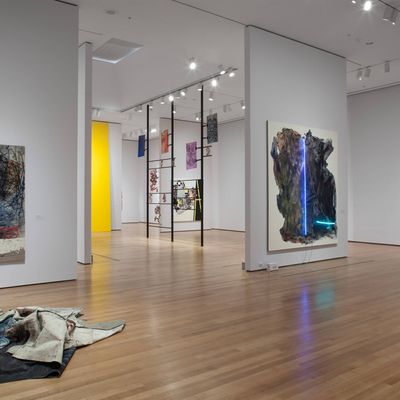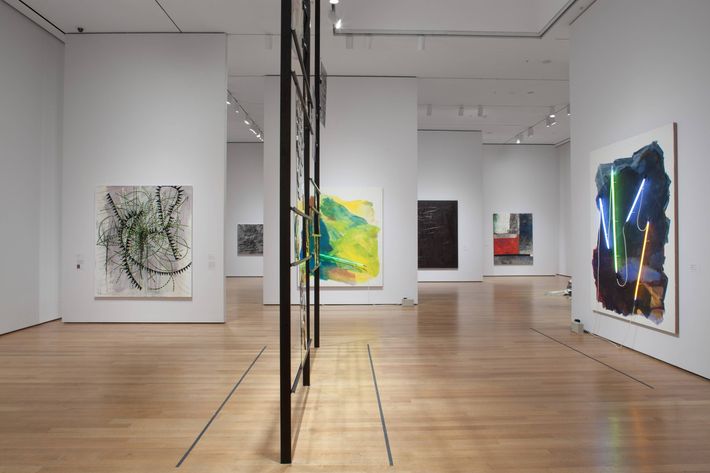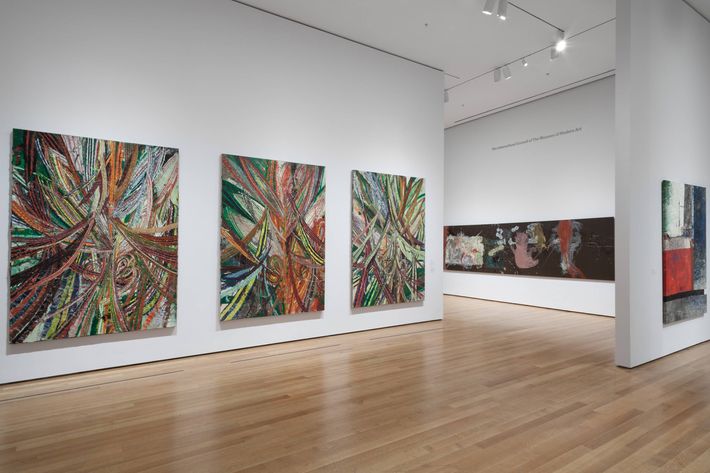
“The Forever Now: Contemporary Painting in an Atemporal World” at the Museum of Modern Art arrives, curated by Laura Hoptman, at a moment when painting is in an astonishingly conflicted but promising abysm of wakefulness. A group show about this stirring medium, at this moment and in the very House of Modernism, sends shock waves through the art world — anointing artists, starting arguments, performing operatically contested desires and new standards. It’s the kind of thing that friends stop being friends over. Or that’s what shows like “The Forever Now” used to be — when time moved slower, information wasn’t instantly accessible everywhere at once, museums were codifiers and curators defending their absolute power positively, or ridiculously. I’m not nostalgic for the dreaded age of curator-bullies, and now that galleries and biennials do most of the codifying, I love that museums have the luxury of time to sift through things rather than react to every twist of aesthetic fate (although too many museums are trying to be like galleries — more on that later). “The Forever Now” is handsome, professional, well intentioned, and has moments that take the breath away. I’m a fan and was an early advocate of a third of its 17 artists. Yet, overall, “The Forever Now” doesn’t capture enough of painting’s pangs, conflict, promise, or current astonishment at its position. Most of all, with a handful of exceptions, the show fails to make a case for the exceptional quality, or truly new character, of contemporary painting; For long stretches, it instead settles for showcasing its ubiquitous presence. If MoMA is the Ferrari of Modernist museums, “The Forever Now” is driving it like a Prius: something made to have minimum impact on the environment while making people feel okay about something troubling.
How did this happen? Hoptman is nobody’s fool. Highly admired, even loved in the art world, she is a lucid thinker and writer and has long been a remarkably perceptive curator, among the first proponents of early-1990s artists like John Currin, Luc Tuymans, Elizabeth Peyton, Gabriel Orozco, and Chris Ofili. I count myself lucky to call her a friend and to have known her for more than 25 years. The roster of artists she has chosen is revealing. Thirteen of the artists in “The Forever Now” are American; all but one of the rest are from Germany. Age-wise, there’s a 30-year spread with Amy Sillman being almost 60 and Oscar Murillo nearly 30. This is not a show to define a generation, since the artists are not of a generation as that term has typically been used. Instead, they are all participants in a cultural moment, in which painting has come to reign supreme, defined by virtuosic newness, of course, but more and more by the basic stylistic sameness valued by the art market and the art fair in particular. To those in the art world, the list of included artists will seem familiar, almost a lineup of acceptable artists and market darlings, many of whom are represented by major spaces or megagalleries like David Zwirner, Hauser & Wirth, and Marian Goodman. (Although a few do not fall into this category.) Many have had museum retrospectives. It’s not the fault of the curator, but most of these artists already fetch enormous prices — some in the millions of dollars — for their work. Indeed, the show’s opening found dealers and art advisers parked in front of artist’s work taking sales orders, as if at an art fair.
That feels odd. The job of forging art history over the last 100 years has probably always been in the hands of galleries and artists more than in museums. But it’s in galleries (and art fairs) more now than ever. This is how it should be, but it has had a deleterious effect of late, causing some curators to transform themselves into Grand Guignol showmen specializing in big productions and spectacle, arriving at every art event, moving on to the next, and in between making atrium exhibitions, film screenings, and the like. Other curators contract, demonizing anything successful or of the art world and embrace a kind of Curatorial Correctness — specializing in the rediscovery of the assistants of famous artists or other overlooked makers of the recent past (in other words, safer, quieter projects that make fewer grand claims about what is new or newly important). Some say that the market has taken over everything. There was a panel this week titled “Zombie Formalism,” the term for precisely this kind of look-alike abstraction. Painter Walter Robinson who coined the term, remarked, “If bad abstraction is the problem then the virus spreading it is money.” It’s true — the market loves abstraction as an easy-on-the-eyes investment and surefire sign of being avant-garde and radical. But Hoptman is too good a curator, with too much integrity, to ever follow the whims of the market. Yet so many of the artists in “The Forever Now” are critically or market approved that the exhibition has the feel of the validation of the inevitable. How does this happen, and what does it mean? Maybe it’s that curatorial impulses and market judgments are no longer separate enough that it makes sense to talk about one or the other taking over.

Hoptman writes in the catalogue that “the seventeen artists in this show are stalwart practitioners of painting qua painting.” For those not conversant in art-speak, “painting qua painting” means, technically, painting as painting. What it seems to mean to those in the art world is painting about painting. Or painting about the processes of making paintings; or about the history of making paintings; or maybe about painting’s modes, compositional approaches, color theories, materials, marks, and subject matters. Or something. Frankly, this is not all that different from what we used to simply call “abstract painting.” And in fact, it’s not hard to see the painting collected here, and the broader painting universe from which it’s drawn, partly as an expression of some nostalgia about earlier eras, when experiments with form seemed to offer something like truly radical content. (There are numerous gestural similarities to the painting of the Abstract Expressionists and the Neo-Expressionists.) Not to say these painters would necessarily acknowledge any of that; I suspect that each one of the included artists would emphatically say that his or her work is not “qua” painting but just painting.
As for what the show says, its subtitle is “Contemporary Painting in an Atemporal World.” Atemporal refers to the conceit that all artistic styles — from cave painting to Pop Art back to Impressionism and Chinese ink drawings — are current, because we see them in the present, a present that collapses the sprawling palimpsest of history and geography into the flat screens of our smartphones. In this view, painterly styles, schools, and gestures all exist free from the limitations of time, history, and, perhaps especially, Modernism’s imperious dictate about always having to change style in order to be Modern, novel, and worthy. All art has always come from other art, and artists have always dug into, repurposed, and outright stolen from and made styles, tendencies, and approaches their own. But the conceit of “The Forever Now” is, I think, that something is different now, that Modernism’s incessant ever-forward march seems so last century, so debunked, and with the combined knowledge of the known universe essentially in our pockets, more artists know about more art than ever before. This is probably true. And because of that, the title suggests, they are making art that, for once, isn’t about taking the next step forward in art history. I think.
But let’s put aside the rhetoric and look at what the show itself tells us. As is often the case with MoMA these days, “The Forever Now” is wedged into too little space. Paintings are hung salon-style, wedged in, given attenuated spaces and little bins, or installed near the top of tall walls meant only for showing the work of Richard Serra. It would have been better had Hoptman been allowed to do 17 one-month one-person shows of each one of these artists somewhere in MoMA to really drill down into their own ideas and make a real statement.
Looking around at the statements made by what has been hung, Laura Owens, Nicole Eisenman, Michael Williams, Michaela Eichwald, Kerstin Bratsch, and Joe Bradley all impress. (Josh Smith does, too, although this may have to do with all of his work being jammed together on one wall and generating this massive graphic impact.) Bradley’s gigantic squiggles and doodles really have grandeur while simultaneously producing a shock of incredulity at how simple and unfinished looking art is, but how powerful of presence. Similarly, Bratsch’s giant paintings on paper encased in steel and glass frames leaned against the walls outside the show’s entrance look like grossly enlarged book end-papers adorned with crenellated turrets of iridescent paint and colorful aigrette crowns gone mad. I love them. Ditto Eichwald’s pliable brown and black Formica-like surfaces of stains, marks, shapes, and scrapes, which have the feel of having gone through excremental fire and survived.
I relish the ropy sluicing surfaces of Mark Grotjahn, but his great paintings seem more excellently old-school than newly atemporal. Stalwarts like Amy Sillman, happy inclusion Mary Weatherford, and Charlene Von Heyl come off well. Von Heyl is, to my eye, the most influential artist in art schools today (almost every student loves to mix up different styles, spaces, and gestures in individual canvasses), but one who is falling into the predictable habit of making all the parts of her painting different. Sillman supplies brushy mid-century-like figurative-abstractions à la de Kooning, Diebenkorn, and Guston. It is a style that is easy to be bad at, and one I don’t often pay much attention to, but in Sillman’s accomplished hands looks strong and also original of color. There are the physically powerful, otherwise bland, almost-monochromes of Rashid Johnson. And some pulled-apart paintings by Dianna Molzan — certainly not a “market approved” artist, as I don’t think she even has a New York gallery — are placeholders for all the generic deconstructivist art (torn or otherwise attacked canvases, exposed stretcher bars, etc.) that’s all the rage. And endlessly boring. Matt Connors, whom I’m usually not a fan of and who is the show’s token Zombie Formalist, looks fantastic here with a gigantic, leaning three-panel painting that is Ellsworth Kelly and Brice Marden made by Richard Serra. It is painting as architectural fact. International art star and market phenom Oscar Murillo shows his impressive Schnabel-like touch and wonderful color in works that are warm and would look lovely in any living room. Beyond that, they are only elegant. Speaking of which, Julie Mehretu, whose handsome work strikes me as merely decorative, makes a welcome move here. Brava. The problem is that now she’s making sooty Cy Twomblys.

So: There is good painting in “The Forever Now.” Very good. Some great. (The show’s last wall of Michael Williams finds an artist so adept at creating complex surfaces that it’s hard to even fix our focus on them.) But it is far too narrow in its focus, giving us only one known strain of contemporary painting that, while shadow-dancing with various methods of reproduction and processes, is all more or less handmade and mostly abstract. That’s it. What does all this abstract atemporality and gestural painting add up to? In the case of the artists I don’t like, I’d say that dipping into any and all styles of painting and abstraction is a way not to address the anxieties that now exist around painting in general and abstraction specifically. It’s become a kind of shelter and sanctuary where instead of making old ideas new (as many artists do now), these artists make old ideas palatable, unthreatening, un-conflicted. Or they make paintings that look like edgy hard-core abstraction, deploying fields of black or monochrome paint; Polke, Richter, or Oehlen–like effects; splashes; all-over composition; switching styles willy-nilly within works. These are all familiar signals that say to viewers and buyers, “I know I’m an abstract painting, but the fact that I know that means that I’m cool and you knowing that I know it makes you cool too. Plus, I’m not crass like Jeff Koons and Takashi Murakami. Like me.” It’s both too confident and too needy. I call this assertive negative content — art whose primary content is what it’s not. And it’s a startling statement that this negative content is so appealing to people (collectors especially) right now.
But what is truly missing here is the sense of painterly anxiety. Not enough of “The Forever Now” lets us in on the storms gathering in the medium, where there is an epic struggle going on, not in spite of the disappearance of modernism’s teleology but precisely because painters working today have had that universe of possibilities collapse on them. On the one hand, artists are ultra-aware of and therefore in an ironical position to painting’s processes, endless tropes, styles, ideas, and, therefore, their own work. Perhaps it’s been ever thus, but it’s more thus than ever. An artist using Day-Glo color today is also using Warhol; every brushstroke references a hundred other artists; painting on fabric might be Polke, Kippenberger, Salle, Oehlen. And so on — not absolutely, not every time, not intentionally, even, but it’s there. History and style are now extra-active content.
If that were that, we’d be dealing only with self-conscious work. The complication is that while artists are in this ironical position to painting, to them their work is not ironic at all — in fact, it is completely, utterly sincere. Today, artists have an almost Romantic relationship to their own work — even if it is made in a time when they are as self-aware as almost never before. This is because the need to make art and the drive to be an artist still run as deep as ego and insecurity towers high. The tension that now exists between these two previously opposed, now concurrent states, is fusing in some new powerful emotion of being at once sincere and ironic. It is a new interior emotion and the tremendously productive chasm and chaos alive in painting and much art today. I’m thinking, for example, of the blasted-looking abstract paintings of Lucy Dodd; the scorching color and rash repeating orders of Katherine Bernhardt; the erratic organization and Eros of Keltie Ferris; the maybe-too-pretty but hobbled Modernism of Patricia Treib; the all-out discontentedness and retinal attack of Bjarne Melgaard; the insane glutted flat surfaces of Borna Sammak.
While I like a lot of the artists in this show, the exhibition as a whole fails to deliver up the restless interiority, forming intellectual constructions, and exigencies that this split is producing. There are places beyond just using abstraction as a cruise ship or tasting menu. These places can be glimpsed in “The Forever Now.” But the show doesn’t venture far enough into this charged, pathos-filled, maybe magisterial arsenal of internal and historical anxiety, insatiable introspection, and outward amplitude. If art really has broken free of time and history — more of the art in “The Forever Now” would not cling to or look like so many of its known safe lifelines. More of this art would not look like what more and more art looks like. That’s why I love the artists I love in this show, and even more why I love all of the artists I love who are not in this show. I almost don’t know what to call what they’re making now or how to see it — except with my nerves.





